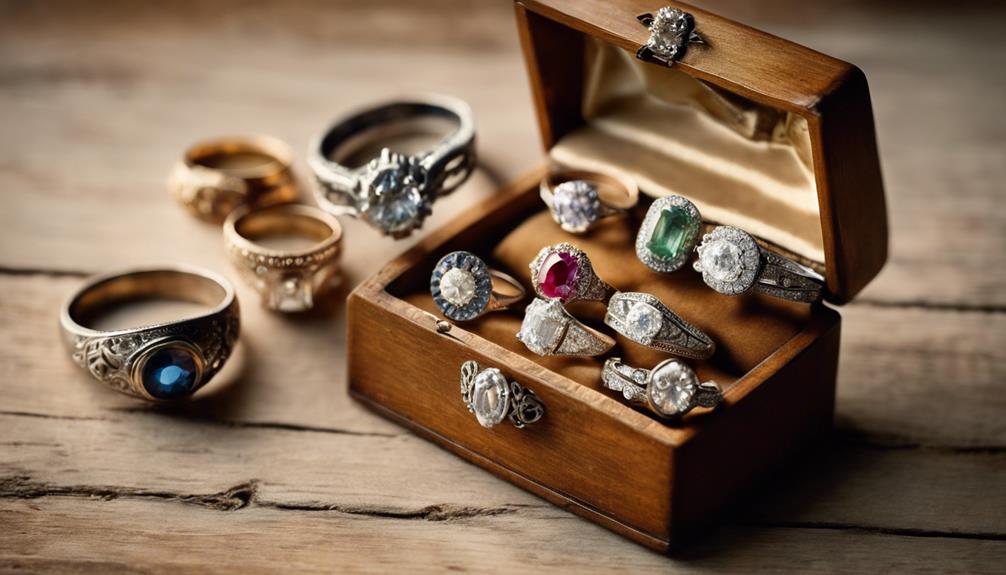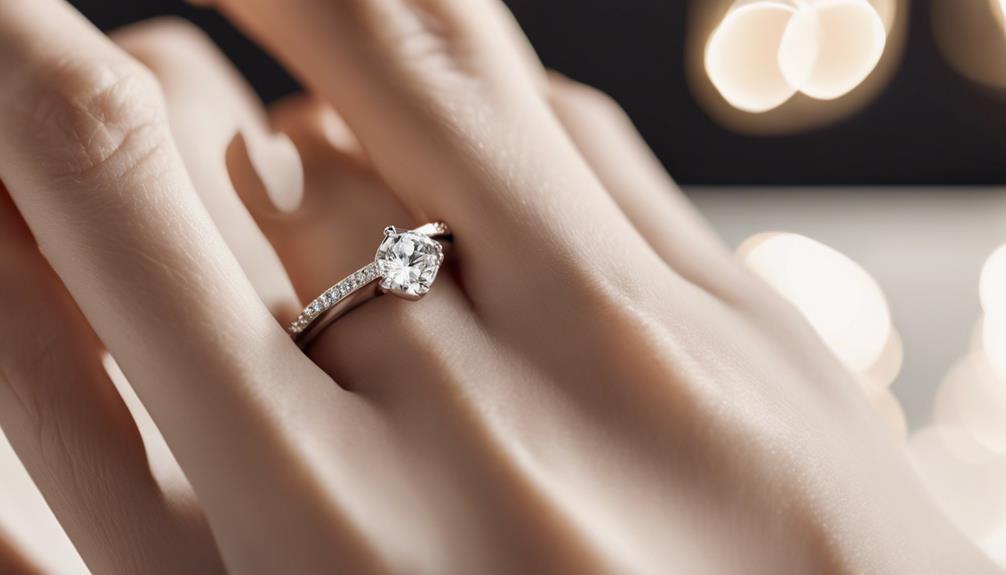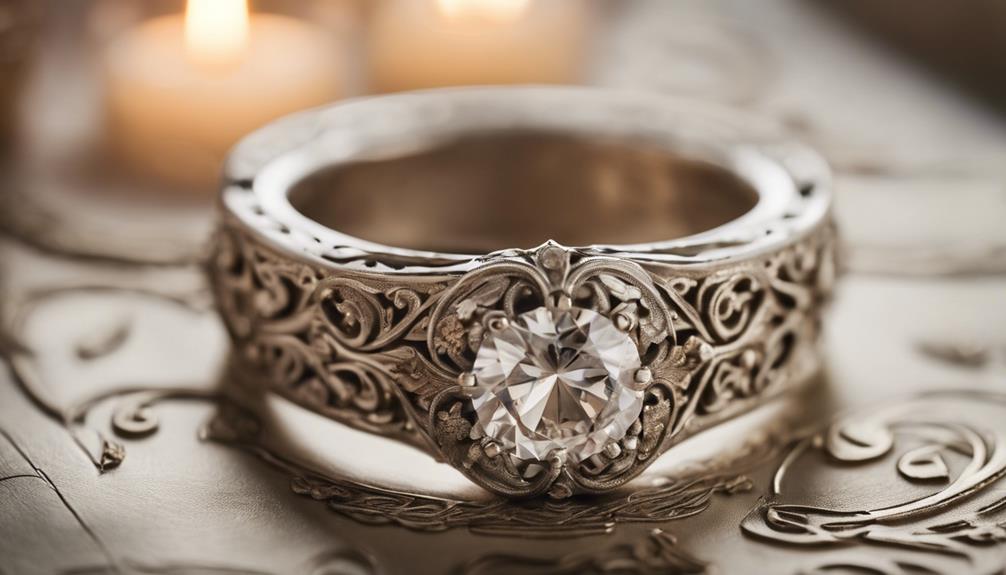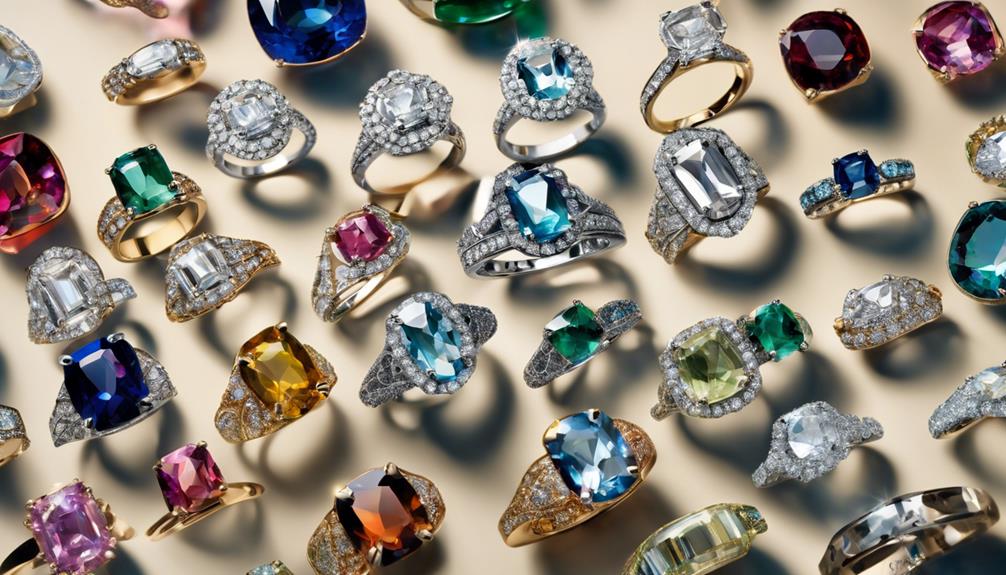Did you know engagement rings date back to Ancient Egypt, symbolizing eternity and commitment? Traditionally worn on the third finger, it was believed a vein, the “Vena Amoris,” ran directly to the heart. Archduke Maximilian of Austria gave the first recorded diamond ring in 1477, creating a timeless tradition. Today, trends include colored gemstones like sapphires and emeralds, while lab-grown diamonds offer eco-friendly options. In Chile, both partners exchange rings, reflecting equality. Irish Claddagh rings stand for love, friendship, and loyalty. Across cultures and time, engagement rings carry deep symbolism. There’s so much more to explore!
Historical Origins

Engagement rings have a fascinating history that dates back to Ancient Egypt, where they symbolized eternity and commitment. You can imagine the ancient Egyptians, with their belief in the endless circle of life, using these rings to signify a bond that transcends time.
They wore these symbols of eternal love on the third finger, which was believed to have a direct vein to the heart, emphasizing the emotional connection.
Fast forward to 1477, when Archduke Maximilian of Austria set a significant precedent by gifting the first recorded diamond engagement ring to Mary of Burgundy. This gesture not only marked the beginning of the diamond engagement ring tradition but also reinforced the idea of using precious stones to symbolize everlasting love and commitment.
It’s no wonder diamond engagement rings have retained their allure and continue to be a popular choice today.
Throughout history, engagement rings have evolved, but their core symbolism remains unchanged. From gimmel rings with interlocking bands in the Middle Ages to modern designs, each ring tells a story of love and unity.
Today, when you choose an engagement ring, you’re embracing a tradition as old as Ancient Egypt itself.
Cultural Variations
While the historical origins of engagement rings lay a foundation for understanding their significance, exploring cultural variations reveals a tapestry of traditions that add depth and uniqueness to the practice.
In Chile, for instance, the engagement process involves both partners exchanging rings, which are typically worn on the right hand. This symbolizes equality and mutual commitment, highlighting the cultural significance of the tradition.
Similarly, in Argentina, rings are exchanged as a mutual promise, reinforcing their importance in romantic commitments.
In Northern and Eastern Europe, it’s common to wear engagement rings on the right hand, contrasting with the left-hand tradition prevalent in many Western countries. This variation underscores how cultural contexts influence the engagement process and the significance attributed to these rings.
Ireland offers another fascinating twist with the Claddagh ring, a symbol of love, friendship, and loyalty. It embodies deep cultural meanings that extend beyond mere adornment, showcasing a unique engagement tradition.
Additionally, Leap Year Day in Ireland is when women propose to men, challenging conventional gender roles and adding another layer to the cultural fabric of engagement rings worn worldwide.
Each tradition enriches our understanding of love and commitment across cultures.
Modern Trends

In today’s world, engagement ring shopping has evolved into a collaborative experience for many couples, marking a shift toward shared decision-making. This change allows you to create a ring that truly reflects your unique relationship and personal tastes.
Modern trends offer exciting options that go beyond the traditional diamond solitaire.
- Colored Gemstones: Sapphires, emeralds, and other vibrant stones are becoming popular alternatives to the classic diamond, adding a splash of color and individuality to your engagement ring.
- Custom-Designed Rings: Personalization is key, and custom-designed rings let you craft a one-of-a-kind piece that tells your story. Whether it’s incorporating meaningful symbols or unique settings, the possibilities are endless.
- Lab-Grown Diamonds: These stones provide an affordable and eco-friendly choice, offering the same sparkle as natural diamonds without the hefty price tag or environmental impact.
Vintage styles are also making a significant comeback, with many couples drawn to the charm and intricate details of antique designs.
These rings often highlight historical craftsmanship, giving you a timeless piece that stands out.
Whether you lean towards colored gemstones or custom creations, modern trends guarantee your engagement ring is as unique as your love story.
Gemstone Alternatives
Exploring gemstone alternatives opens up a world of vibrant possibilities for your engagement ring. While diamonds are the traditional choice, considering alternatives like sapphires and emeralds can add a splash of unique colors to your ring.
Sapphires, especially in their classic blue hue, aren’t only stunning but also symbolize loyalty and nobility—qualities that resonate well in a lifelong commitment. Emeralds, with their rich green color, offer a lush and sophisticated look, perfect for those wanting something a bit different.
Opting for colored gemstones can also be more budget-friendly, allowing you to choose larger stones or more intricate settings without breaking the bank. Moissanite is another excellent option, gaining popularity for its incredible brilliance and durability, closely rivaling diamonds in hardness but at a fraction of the cost.
If you’re drawn to the charm of the past, vintage rings often feature these unique gemstones, giving you a one-of-a-kind piece with a story.
These rings not only stand out due to their distinctive design but also offer a personalized touch that reflects your individual style and story, moving beyond the traditional diamond path.
Symbolism and Beliefs

Throughout history, engagement rings have been laden with symbolism and beliefs, serving as powerful tokens of love and commitment. Dating back to Ancient Egypt, these rings symbolized eternity, reflecting the perpetual bond between partners.
The tradition of wearing the engagement ring on the third finger of the left hand is rooted in the ancient belief of the Vena Amoris, a vein thought to connect directly to the heart, emphasizing the emotional connection and commitment involved.
Throughout the ages, the materials and designs of engagement rings have varied, highlighting cultural nuances and societal values:
- Ancient Rome: Rings made of iron for everyday use and gold for public display, showing societal norms and expectations.
- Middle Ages: Posy rings engraved with love poetry, underscoring the emotional depth attached to these symbols.
- Chile: A unique tradition where both partners exchange rings as a sign of equality in the engagement.
As you explore these traditions, it’s clear how engagement rings have been more than just a piece of jewelry. They’re symbols of commitment and love, evolving with each era and culture to express personal stories and beliefs.
Conclusion
As you wrap up your journey through the enchanting world of engagement rings, remember that you’re not just choosing a piece of jewelry; you’re selecting a symbol steeped in history and personal significance. Whether you opt for a classic diamond or a unique gemstone, your ring will reflect both timeless traditions and your distinctive love story. Embrace this opportunity to honor the past while celebrating your future together with a ring that’s uniquely yours.



